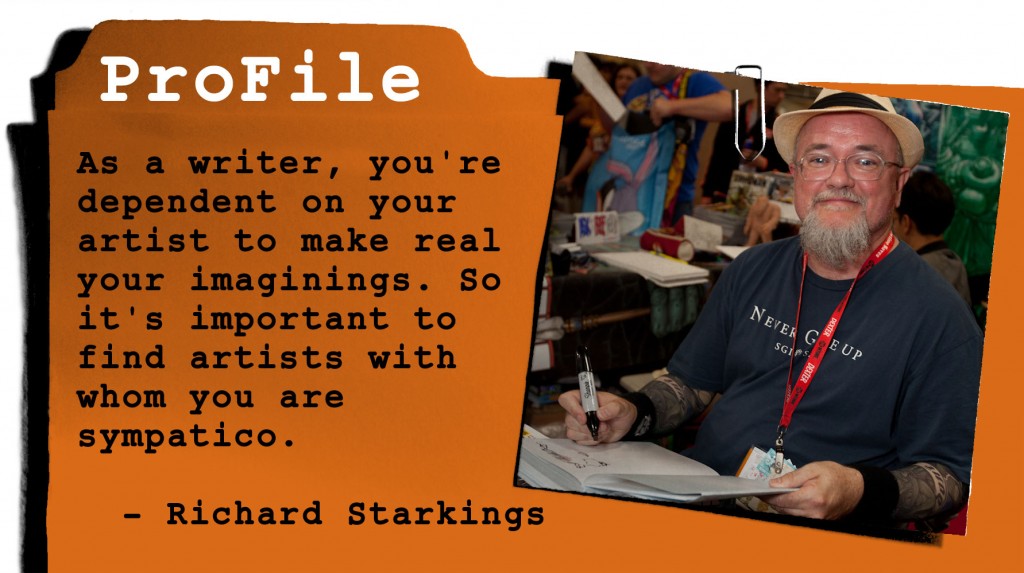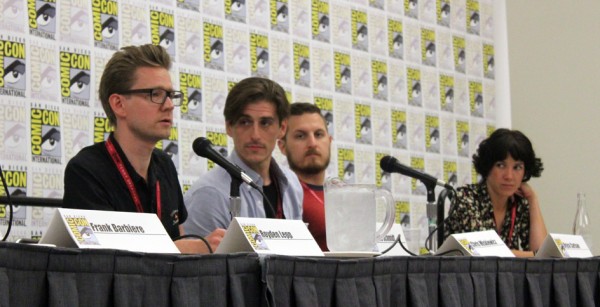Is there a right way to hold a pen or a pencil when you draw?
One of my YouTube chanel followers seems to think so. And it’s NOT how I hold a pencil!
How to Write & Draw Comics
One of my YouTube chanel followers seems to think so. And it’s NOT how I hold a pencil!
 Richard Starkings is the creator and writer of HIP FLASK and ELEPHANTMEN. Born and raised in England, Starkings worked for five years at Marvel UK’s London offices as editor, designer and occasional writer of ZOIDS, GHOSTBUSTERS, TRANSFORMERS and the DOCTOR WHO comic strip. He is perhaps best known for his work with the award-winning Comicraft design and lettering studio, which he founded in 1992 with John ‘JG’ Roshell. Starkings & Roshell also co-authored the best-selling books COMIC BOOK LETTERING THE COMICRAFT WAY and TIM SALE: BLACK AND WHITE.
Richard Starkings is the creator and writer of HIP FLASK and ELEPHANTMEN. Born and raised in England, Starkings worked for five years at Marvel UK’s London offices as editor, designer and occasional writer of ZOIDS, GHOSTBUSTERS, TRANSFORMERS and the DOCTOR WHO comic strip. He is perhaps best known for his work with the award-winning Comicraft design and lettering studio, which he founded in 1992 with John ‘JG’ Roshell. Starkings & Roshell also co-authored the best-selling books COMIC BOOK LETTERING THE COMICRAFT WAY and TIM SALE: BLACK AND WHITE.What made you decide to work in the medium of comics?
I always loved comics — at the age of 9 I started reading a comic called COUNTDOWN featuring strips based on TV shows like DOCTOR WHO, UFO and THE PERSUADERS. In some ways I preferred them to the TV shows they were based on. That comic inspired me to draw comics and cartoon strips myself and from that young age I started identifying the artists and styles I liked.
Years later, I remember reading an article in Dez Skinn’s WARRIOR magazine in the 80’s about breaking into comics. I was on a train from Weymouth to London and I kind of realized at that moment that it was possible to get a job in comics and committed myself to that goal. I never seriously considered anything else.
What part of the process is the most challenging or frustrating to you?
As a writer, you’re dependent on your artist to make real your imaginings. So it’s important to find artists with whom you are sympatico. Finding those creators can be very rewarding and challenging all at the same time.
If you could give one piece of advice to an aspiring comics creator, what would that be?
Write! Draw! ALL the time. Write about life, draw from life.
More about Richard Starkings and Elephantmen on hipflask.com
A time-lapse video of me painting a page of Thomas Alsop from BOOM! Studios. Hopefully some helpful tips here. More on the book at thomasalsop.com
Related videos: Sketching a page of Thomas Alsop

For many years I suffered from the delussion that “real” writers worked from page 1 until the book was finished. This resulted in many a stranded story for me. When I finally gave myself permission to go ahead and skip to the ending or the middle, if I had an idea for that, my creative juices really started flowing.
These days I’ve also allowed myself the luxury of jumping from one project to the other, and I find it works the same way for me. Instead of standing still, I go in another direction, keeping the forward momentum.
Every project is a learning experience, every story brings new ideas. I can skip from one story to another, using what I just learned for something else, perhaps as a way to get unstuck on a story problem or motivational issue.
The downside of working on multiple things at once, is that you can get the feeling you’re not going anywhere. That you are just spinning wheels when in fact you are moving forward.
The need to focus in certain phases can be neccessary
Jumping around is fun, but to finish something, you need some crunch time. I always seem to forget that stories and projects don’t push themselves into my work day. I have to put them there, block out time to work on them. If I wait until I get some free time or get “inspired”, I will take all these projects with me to my grave. Unfinished.
As Stephen King once says in his book On Writing:
Amateurs sit and wait for inspiration, the rest of us just get up and go to work.
My method of jumping from one project to another might not be for you. But as long as you finish them eventually, (see this post on finishing) I see no problem with working on five things at once. It might just spark that creative energy that keeps the creativity flowing instead of running dry…
Do you work best with one thing at a time or are you a scatterbrain like me? Let’s hear your story!
“There’s a reason why they punish prisoners by putting them in solitary”. Steve Lieber, long time comics pro and the current artist on The Superior Foes of Spider-Man, speaks highly of the studio environment. And as a founding member of Periscope Studio in Portland, OR, he has the experience to back it up. I talked to Steve about the advantages and the pitfalls of joining or creating a studio. For more on Periscope, go to http://www.periscopestudio.com or follow them on Twitter @periscopestudio. Steve is @steve_lieber and on www.stevelieber.com. Other resources mentioned in this episode: http://www.workmadeforhire.net/blog/
http://www.zanaducomics.com/

My partner Chris Miskiewicz and I pitched Thomas Alsop to several publishers at SDCC 2013, and now only a year later, BOOM! Studios has published the two first issues of the series. Crazy times.
I got invited on two panels this year, both the Breaking Into Comics Right Now panel hosted by BOOM! and the Uniting the Worldwide #makecomics Community panel, hosted by my friends over at Making Comics (In case you missed the podcast interview they did with me, click here) starring Mark Waid, Jim Zub, Christy Blanch, Rachel Beck and Andy Schmidt. The talk was recorded and will probably go online soon.
I could tell you stories… But most of them are unrelated to the process of making comics, which is what this site is about. So I’ll just share a few quick things I learned:
The next few weeks I’ll be working out of Periscope Studios in Portland, Oregon, making new contacts and slow progress on the next issue of Thomas Alsop. Stay tuned…
If you have questions or issues please contact us.
Official mail: mail(at)comicsforbeginners.com